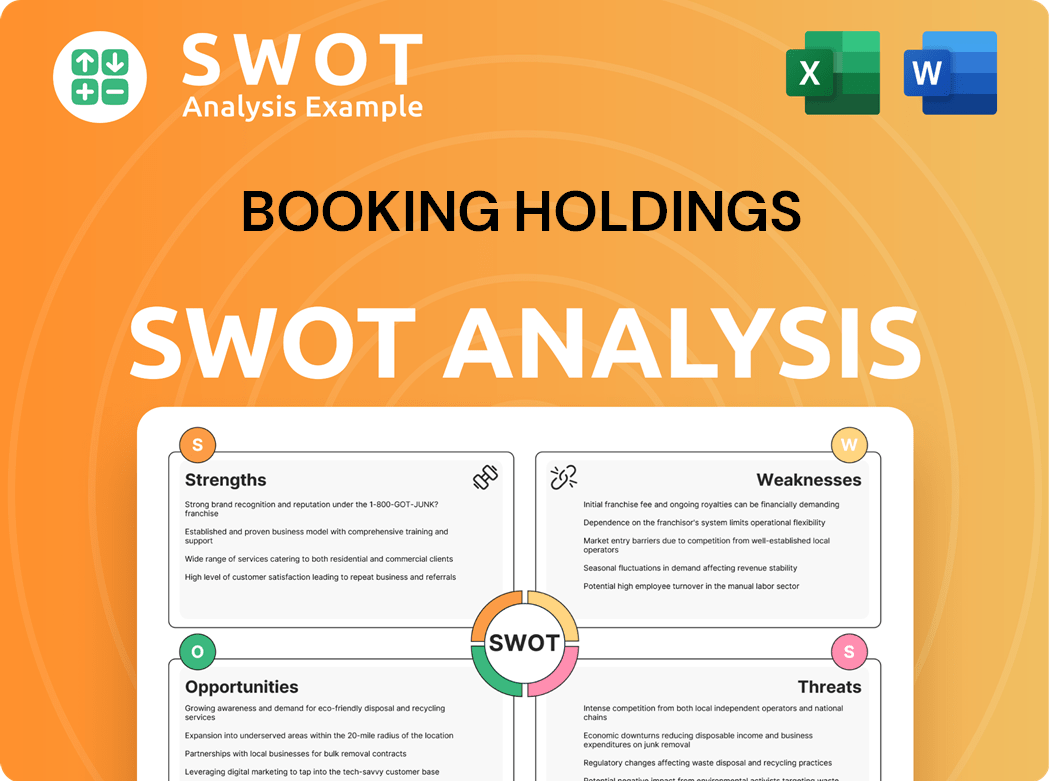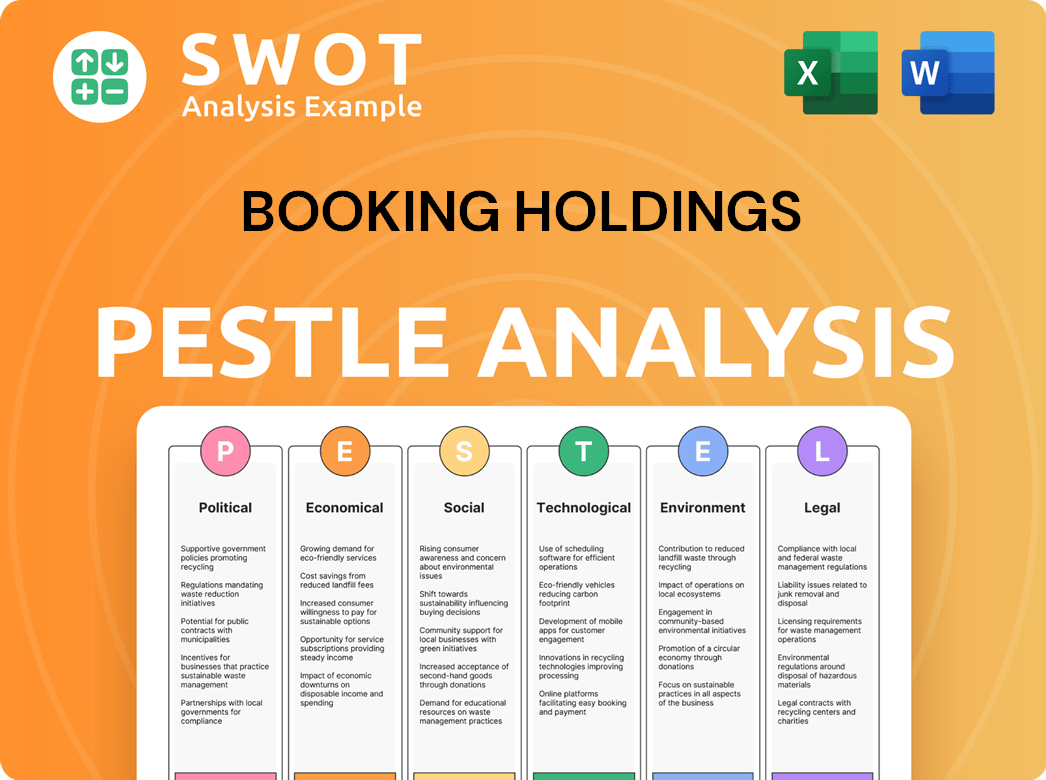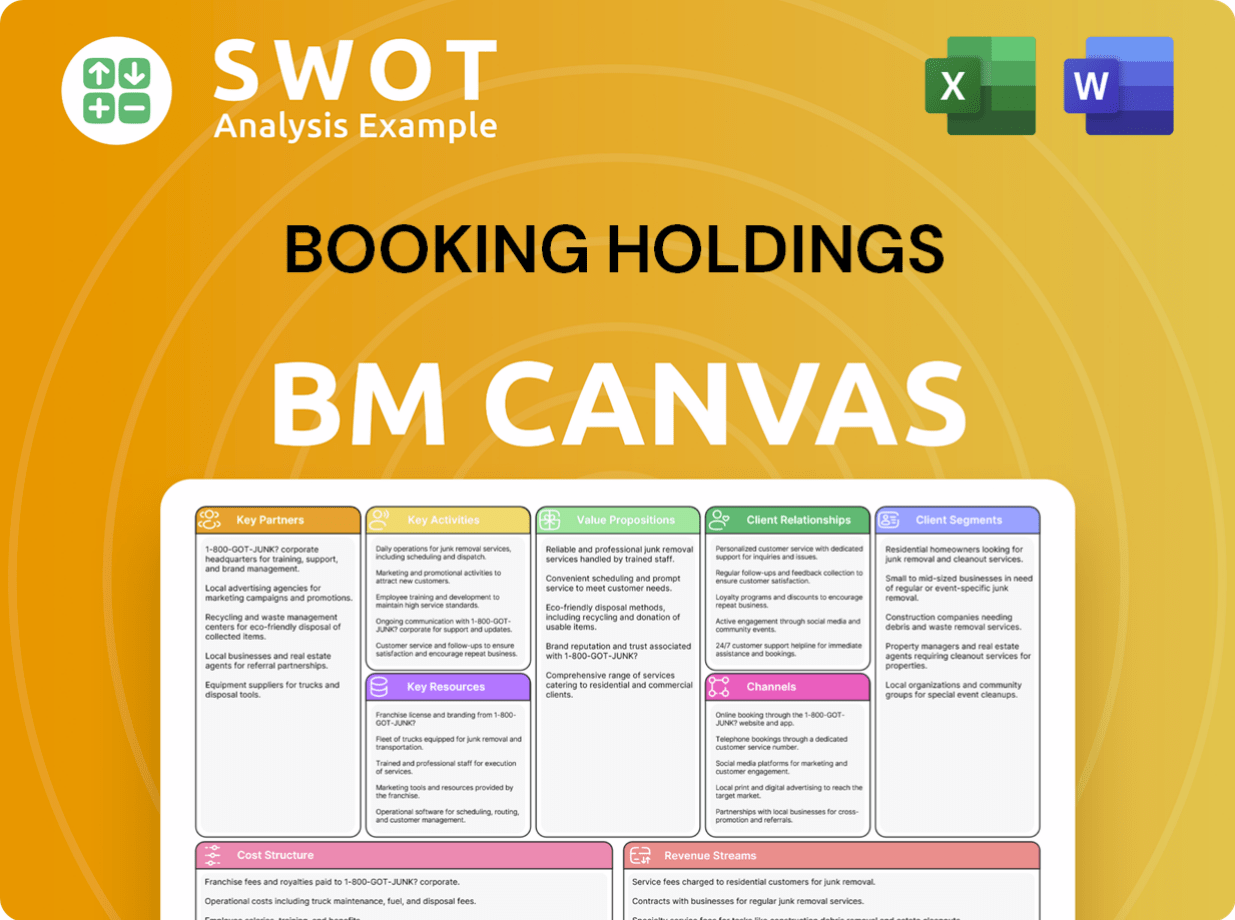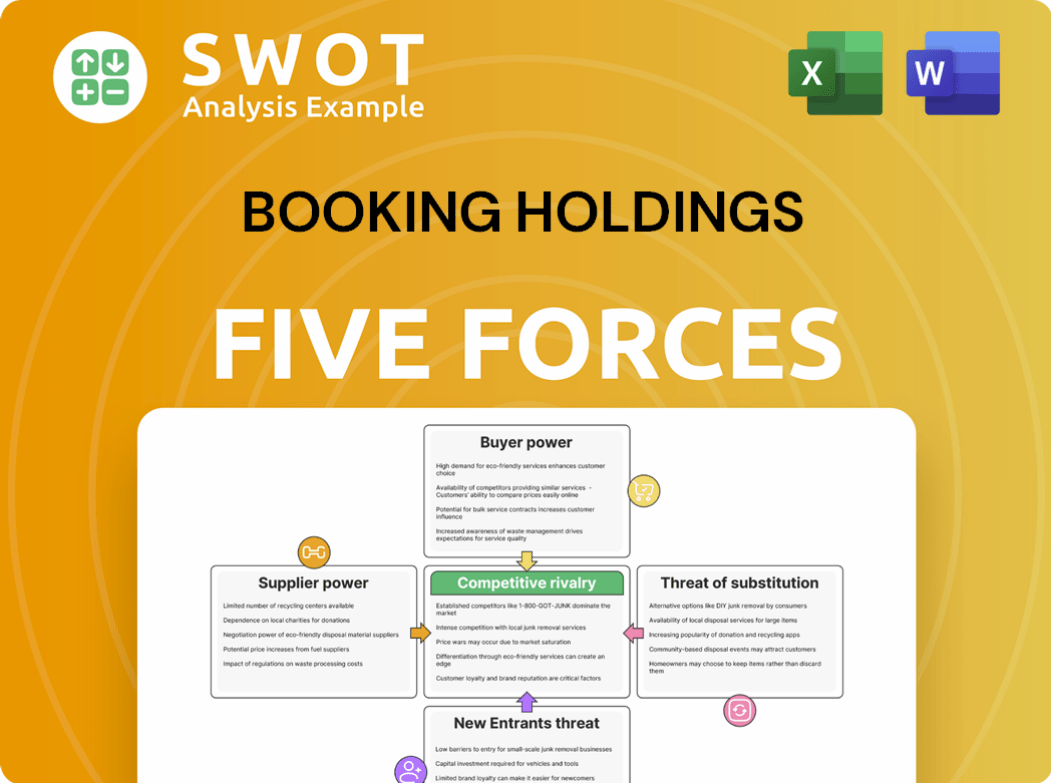Booking Holdings Bundle
How Does Booking Holdings Dominate the Travel Market?
From its humble beginnings as Priceline.com, Booking Holdings has revolutionized the travel industry. Remember the iconic "Booking.yeah" campaign? It wasn't just an ad; it was a game-changer. Now, with a vast portfolio of brands, including Booking.com, Booking Holdings' strategic moves continue to shape how we explore the world.

This exploration of Booking Holdings' Booking Holdings SWOT Analysis will uncover the core of its success, examining the evolution of its Booking Holdings sales strategy and Booking Holdings marketing strategy. We'll dissect its innovative Booking Holdings business model, revealing how this online travel agency giant leverages digital prowess, strategic partnerships, and global reach to stay ahead in the competitive travel industry marketing landscape. Furthermore, we will analyze how the company, formerly known as Priceline Group, continues to adapt its approach to resonate with travelers worldwide.
How Does Booking Holdings Reach Its Customers?
The sales strategy of Booking Holdings heavily relies on a robust network of online sales channels. These channels are primarily e-commerce platforms, each dedicated to a specific area of travel and related services. This approach allows the company to reach a broad global audience effectively.
The company's primary consumer-facing brands, including Booking.com, Priceline, Agoda, Rentalcars.com, KAYAK, and OpenTable, act as distinct online portals. Booking.com, for instance, operates on an agency model, while Priceline has evolved from its 'name your own price' model to include more traditional booking methods. This diversification caters to different customer preferences and market segments.
Continuous digital adoption and optimization are crucial for the evolution of these channels. While physical retail locations are not a primary sales channel, the company invests heavily in its online presence. Mobile bookings have become a significant revenue driver, with Booking.com reporting over 50% of its room nights booked on mobile devices in recent years.
Booking Holdings utilizes several online platforms, each catering to different travel needs. These platforms include Booking.com, Priceline, Agoda, Rentalcars.com, KAYAK, and OpenTable. These platforms are the core of the company's sales strategy.
Mobile bookings are a significant driver of revenue for Booking Holdings. Booking.com has reported that over 50% of its room nights are booked on mobile devices. This shift highlights the company's strategic focus on mobile-first engagement.
Partnerships with airlines, car rental companies, and restaurants expand Booking Holdings' reach. These partnerships, facilitated through platforms like KAYAK and OpenTable, enhance the overall customer journey. They contribute significantly to growth and market share.
Booking.com operates on an agency model, facilitating bookings between travelers and accommodation providers. This model allows for a wide array of inventory without directly owning properties. This model has been instrumental in its rapid global expansion.
Booking Holdings' sales strategy is primarily digital, focusing on its online platforms and mobile applications. The company leverages various models, including the agency model used by Booking.com, to cater to diverse customer preferences. Strategic partnerships also play a crucial role in expanding its reach and offering integrated solutions.
- Online Platforms: Booking.com, Priceline, Agoda, Rentalcars.com, KAYAK, and OpenTable.
- Mobile-First Approach: Significant revenue from mobile bookings.
- Partnerships: Collaborations with airlines, car rental companies, and restaurants.
- Agency Model: Facilitates bookings and global expansion.
- For more details on the company's overall strategy, see Growth Strategy of Booking Holdings.
Booking Holdings SWOT Analysis
- Complete SWOT Breakdown
- Fully Customizable
- Editable in Excel & Word
- Professional Formatting
- Investor-Ready Format

What Marketing Tactics Does Booking Holdings Use?
The marketing tactics employed by Booking Holdings are extensive and primarily digital, designed to drive sales and enhance brand visibility across its portfolio of online travel agency brands. Their strategy emphasizes a data-driven approach, leveraging a variety of digital channels and sophisticated analytics to optimize customer acquisition and retention. This multi-faceted approach is crucial for maintaining its market share in the competitive travel industry.
Digital marketing forms the core of Booking Holdings' strategy, with significant investments in search engine optimization (SEO), paid advertising, and content marketing. Email marketing and social media also play key roles in customer engagement and brand building. By continuously refining its marketing mix, Booking Holdings aims to maximize its return on investment and maintain its position as a leader in the online travel market.
A key element of the Booking Holdings sales strategy involves a robust digital presence, with a strong emphasis on performance marketing. This includes continuous A/B testing to improve website conversion rates and the use of machine learning to personalize recommendations and optimize ad spend. The company's focus on measurable ROI allows it to adapt quickly to market changes and customer preferences, ensuring efficient allocation of marketing resources.
The foundation of Booking Holdings' marketing strategy is digital. It includes SEO, paid advertising, and content marketing. This approach ensures high visibility and effective customer acquisition in the online travel agency space.
Booking Holdings invests heavily in both SEO and paid advertising, particularly on platforms like Google Ads. This strategy is vital for capturing demand and driving traffic to its various platforms.
Email marketing is a key component of Booking Holdings' customer retention strategy. It uses personalized offers and re-engagement campaigns to maintain customer loyalty and drive repeat bookings.
Social media platforms are used for brand building and promotional content. The focus is on practical travel inspiration rather than celebrity endorsements, creating an authentic connection with potential customers.
Booking Holdings uses advanced analytics to understand customer behavior and segment audiences. A/B testing is routinely employed to optimize website conversion rates and marketing campaign effectiveness.
While digital channels are prioritized, traditional media such as TV are used for broad brand awareness. Machine learning and AI are integrated for dynamic pricing and personalized recommendations.
The company's approach to marketing is highly sophisticated, leveraging data analytics to understand customer behavior and personalize offerings. This data-driven strategy is crucial for optimizing the customer acquisition cost and maximizing the return on investment in marketing campaigns. For example, in 2024, the company's advertising spend was a significant portion of its revenue, reflecting its commitment to maintaining a strong online presence. The company's ongoing investments in digital marketing, including SEO and paid advertising, are essential for capturing market share and driving revenue growth in the competitive online travel agency landscape. For a deeper dive into the financial aspects, you can explore the insights provided in this analysis of the Booking Holdings business model.
Booking Holdings' marketing strategy is built on several key pillars, each contributing to its overall success in the travel industry. These elements work together to create a comprehensive and effective approach to customer acquisition, retention, and brand building.
- Digital Marketing Focus: Prioritizes digital channels such as SEO, paid advertising, and content marketing for maximum reach and measurable ROI.
- Data-Driven Decisions: Employs advanced analytics and A/B testing to understand customer behavior, personalize offerings, and optimize campaign effectiveness.
- Customer Retention: Utilizes email marketing for personalized offers and re-engagement campaigns to maintain customer loyalty.
- Brand Building: Leverages social media platforms for brand building and promotional content, focusing on practical travel inspiration.
- Innovation: Integrates machine learning and AI for dynamic pricing, personalized recommendations, and optimizing ad spend.
Booking Holdings PESTLE Analysis
- Covers All 6 PESTLE Categories
- No Research Needed – Save Hours of Work
- Built by Experts, Trusted by Consultants
- Instant Download, Ready to Use
- 100% Editable, Fully Customizable

How Is Booking Holdings Positioned in the Market?
Booking Holdings strategically positions its various brands to capture different segments of the travel market. This approach allows the company to cater to a wide range of customer needs and preferences. The overarching goal is to make travel easier for everyone, a mission supported by distinct brand identities and targeted marketing efforts.
The company's brand portfolio includes several well-known names, each with a specific focus. Booking.com, the flagship brand, emphasizes user-friendliness and a vast selection of accommodations. Priceline targets value-conscious travelers, and Agoda focuses on the Asian market. Rentalcars.com specializes in car rentals, KAYAK offers a meta-search engine, and OpenTable handles restaurant reservations.
This diversified brand strategy allows Booking Holdings to maintain a strong presence in the online travel agency (OTA) space. By understanding the unique value propositions of each brand, the company can effectively reach different customer segments and drive revenue. This approach is crucial for success in the competitive travel industry.
Booking.com is positioned as a user-friendly platform with a vast selection of accommodations. It emphasizes ease of booking and competitive pricing. This appeals to a broad audience seeking convenience and value when planning their trips.
Priceline targets value-conscious travelers seeking discounts. It offers deals on flights, hotels, and car rentals. Historically known for 'name your own price' deals, it continues to focus on providing affordable travel options.
Agoda focuses on the Asian market, offering accommodation deals and localized content. It tailors its services to meet the specific needs of travelers in Asia. This localized approach helps Agoda maintain a strong market presence.
KAYAK is positioned as a meta-search engine, offering transparency and comparison across travel providers. It helps users find the best deals by comparing multiple options. This appeals to users looking for comprehensive travel information.
Booking Holdings employs several key strategies to maintain its brand positioning and drive customer engagement. These strategies are crucial for its success in the competitive online travel agency landscape. The company focuses on adapting to changing consumer preferences and market dynamics.
- Customer-Centric Approach: Prioritizing user experience and customer satisfaction across all brands.
- Technological Infrastructure: Utilizing shared technology to ensure consistency and efficiency across the portfolio.
- Adaptation to Trends: Responding to shifts in consumer behavior, such as the demand for sustainable travel.
- Competitive Analysis: Continuously monitoring and responding to competitive threats in the travel industry.
- Brand Consistency: Maintaining a consistent commitment to customer satisfaction across all brands.
The company's approach to brand positioning is dynamic, adapting to market changes and consumer preferences. For instance, the growing interest in sustainable travel influences how Booking Holdings positions its brands. Furthermore, competitive pressures necessitate continuous adjustments to maintain relevance and appeal. To learn more about the company's overall approach, you can read about the Growth Strategy of Booking Holdings.
Booking Holdings Business Model Canvas
- Complete 9-Block Business Model Canvas
- Effortlessly Communicate Your Business Strategy
- Investor-Ready BMC Format
- 100% Editable and Customizable
- Clear and Structured Layout

What Are Booking Holdings’s Most Notable Campaigns?
The sales and marketing strategies of Booking Holdings are multifaceted, encompassing a range of digital marketing campaigns, brand awareness initiatives, and strategic partnerships. A core element of their approach involves leveraging data analytics to optimize customer acquisition and retention. This data-driven focus allows for personalized experiences and targeted advertising, driving conversions and enhancing customer lifetime value. Understanding the Brief History of Booking Holdings is crucial to grasp the evolution of its marketing efforts.
Booking Holdings employs a diversified approach to reach its target audience, utilizing various channels such as paid search, display advertising, and social media marketing. The company consistently invests in performance marketing to maximize its return on investment. These efforts are complemented by content marketing and SEO strategies to improve organic visibility and attract potential customers. The ongoing competitive analysis within the online travel agency (OTA) landscape influences the continuous refinement of its sales and marketing tactics.
The company's marketing campaigns are often tailored to specific seasons, destinations, and user preferences. These campaigns are designed to drive immediate bookings and build long-term brand loyalty. The company's marketing strategies are continuously adapted based on performance data and market trends. This ensures that marketing spend is allocated efficiently, maximizing conversions and customer lifetime value.
Launched in 2013, 'Booking.yeah' was a significant marketing campaign that boosted brand recognition. The campaign focused on the emotional benefits of travel. It featured humorous scenarios and the catchy 'Booking.yeah' jingle.
Booking Holdings runs targeted digital campaigns across its platforms. These campaigns leverage paid search, display advertising, and email marketing. They often focus on seasonal promotions and personalized recommendations.
Campaigns around major holidays and events like summer travel or Black Friday are common. These are designed to drive immediate bookings. The company focuses on maximizing conversions.
Continuous optimization through data analysis and A/B testing is a key strategy. This ensures marketing spend is maximized for conversions. Customer lifetime value is a primary focus.
Booking Holdings employs several key strategies to acquire customers and maintain its market share. These include a focus on digital marketing, performance marketing, and strategic partnerships.
- Paid Search and Display Advertising: Utilizing platforms like Google Ads to target potential customers with relevant ads.
- Email Marketing: Sending personalized emails to users based on their browsing history and preferences.
- Social Media Marketing: Engaging with potential customers through various social media platforms.
- Content Marketing: Creating valuable content to attract and engage potential customers.
- SEO Strategy: Optimizing the company's website to improve organic visibility.
Booking Holdings Porter's Five Forces Analysis
- Covers All 5 Competitive Forces in Detail
- Structured for Consultants, Students, and Founders
- 100% Editable in Microsoft Word & Excel
- Instant Digital Download – Use Immediately
- Compatible with Mac & PC – Fully Unlocked

Related Blogs
- What are Mission Vision & Core Values of Booking Holdings Company?
- What is Competitive Landscape of Booking Holdings Company?
- What is Growth Strategy and Future Prospects of Booking Holdings Company?
- How Does Booking Holdings Company Work?
- What is Brief History of Booking Holdings Company?
- Who Owns Booking Holdings Company?
- What is Customer Demographics and Target Market of Booking Holdings Company?
Disclaimer
All information, articles, and product details provided on this website are for general informational and educational purposes only. We do not claim any ownership over, nor do we intend to infringe upon, any trademarks, copyrights, logos, brand names, or other intellectual property mentioned or depicted on this site. Such intellectual property remains the property of its respective owners, and any references here are made solely for identification or informational purposes, without implying any affiliation, endorsement, or partnership.
We make no representations or warranties, express or implied, regarding the accuracy, completeness, or suitability of any content or products presented. Nothing on this website should be construed as legal, tax, investment, financial, medical, or other professional advice. In addition, no part of this site—including articles or product references—constitutes a solicitation, recommendation, endorsement, advertisement, or offer to buy or sell any securities, franchises, or other financial instruments, particularly in jurisdictions where such activity would be unlawful.
All content is of a general nature and may not address the specific circumstances of any individual or entity. It is not a substitute for professional advice or services. Any actions you take based on the information provided here are strictly at your own risk. You accept full responsibility for any decisions or outcomes arising from your use of this website and agree to release us from any liability in connection with your use of, or reliance upon, the content or products found herein.